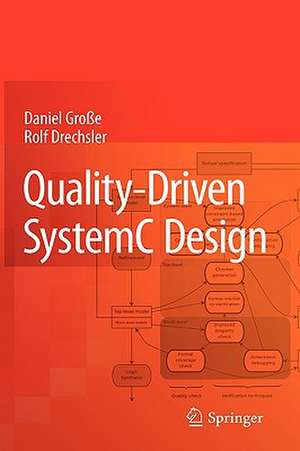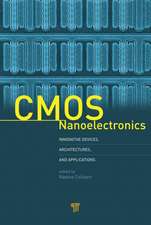Quality-Driven SystemC Design
Autor Daniel Große, Rolf Drechsleren Limba Engleză Hardback – 23 dec 2009
| Toate formatele și edițiile | Preț | Express |
|---|---|---|
| Paperback (1) | 635.31 lei 6-8 săpt. | |
| SPRINGER NETHERLANDS – 16 oct 2014 | 635.31 lei 6-8 săpt. | |
| Hardback (1) | 641.53 lei 6-8 săpt. | |
| SPRINGER NETHERLANDS – 23 dec 2009 | 641.53 lei 6-8 săpt. |
Preț: 641.53 lei
Preț vechi: 754.74 lei
-15% Nou
Puncte Express: 962
Preț estimativ în valută:
122.77€ • 128.01$ • 102.03£
122.77€ • 128.01$ • 102.03£
Carte tipărită la comandă
Livrare economică 21 martie-04 aprilie
Preluare comenzi: 021 569.72.76
Specificații
ISBN-13: 9789048136308
ISBN-10: 904813630X
Pagini: 192
Ilustrații: XIX, 170 p.
Dimensiuni: 155 x 235 x 23 mm
Greutate: 0.45 kg
Ediția:2010
Editura: SPRINGER NETHERLANDS
Colecția Springer
Locul publicării:Dordrecht, Netherlands
ISBN-10: 904813630X
Pagini: 192
Ilustrații: XIX, 170 p.
Dimensiuni: 155 x 235 x 23 mm
Greutate: 0.45 kg
Ediția:2010
Editura: SPRINGER NETHERLANDS
Colecția Springer
Locul publicării:Dordrecht, Netherlands
Public țintă
ResearchCuprins
Preliminaries.- System-Level Verification.- Block-Level Verification.- Top-Level Verification.- Summary and Conclusions.
Textul de pe ultima copertă
Faced with the steadily increasing complexity and rapidly shortening time-to-market requirements designing electronic systems is a very challenging task. To manage this situation effectively the level of abstraction in modeling has been raised during the past years in the computer aided design community. Meanwhile, for the so-called system-level design the system description language SystemC has become the de facto standard. However, while modeling from abstract to synthesizable descriptions in combination with specification concepts like Transaction Level Modeling (TLM) leads to very good results, the verification quality is poor. The two main reasons are that (1) the existing SystemC verification techniques do not escort the different abstraction levels effectively and (2) in particular the resulting quality in terms of the covered functionality is only checked manually. Hence, due to the increasing design complexity the number of undetected errors is growing rapidly.
Therefore a quality-driven design and verification flow for digital systems is developed and presented in Quality-Driven SystemC Design. Two major enhancements characterize the new flow: First, dedicated verification techniques are integrated which target the different levels of abstraction. Second, each verification technique is complemented by an approach to measure the achieved verification quality. The new flow distinguishes three levels of abstraction (namely system level, top level and block level) and can be incorporated in existing approaches. After reviewing the preliminary concepts, in the following chapters the three levels for modeling and verification are considered in detail. At each level the verification quality is measured. In summary, following the new design and verification flow a high overall quality results.
Therefore a quality-driven design and verification flow for digital systems is developed and presented in Quality-Driven SystemC Design. Two major enhancements characterize the new flow: First, dedicated verification techniques are integrated which target the different levels of abstraction. Second, each verification technique is complemented by an approach to measure the achieved verification quality. The new flow distinguishes three levels of abstraction (namely system level, top level and block level) and can be incorporated in existing approaches. After reviewing the preliminary concepts, in the following chapters the three levels for modeling and verification are considered in detail. At each level the verification quality is measured. In summary, following the new design and verification flow a high overall quality results.
Caracteristici
Dedicated verification techniques for the different abstraction levels of System C Verification quality is measured throughout the refinement of the design Integrated design and verification flow















